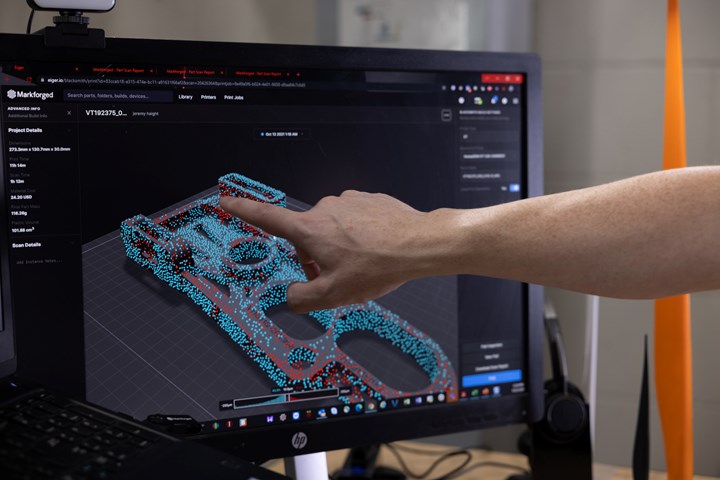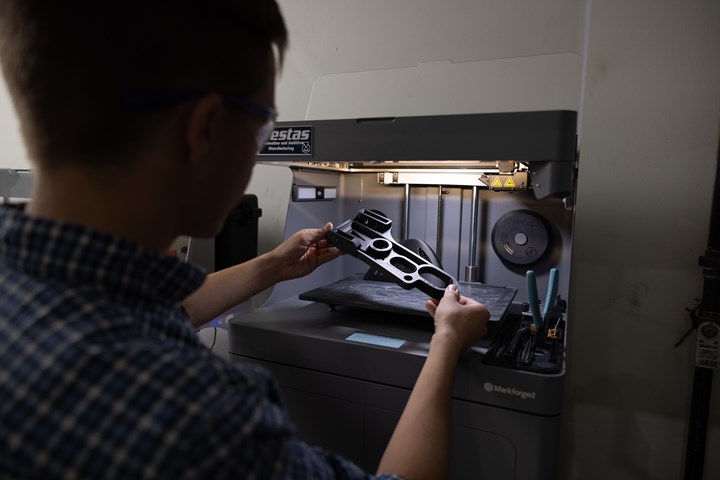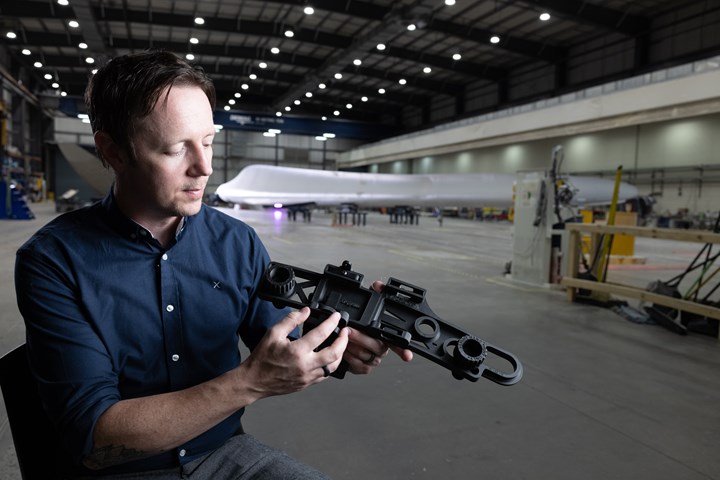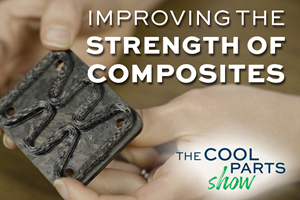Share
Read Next

This piece was originally published by our sister brand, CompositesWorld. Find more information on their website.
Wind turbines are massive and expensive machines that must function reliably with minimal downtime in order to be as effective as possible. That means there’s no room for error when it comes to manufacturing and installation. As a result, wind turbine manufacturer Vestas (Aarhus, Denmark) has depended on specialized inspection gauges at its manufacturing facilities and inspection sites, often requiring parts to be sent between various facilities. However, this process can be time consuming, and adds onto the time and production costs needed to produce specialized wind blade components.
To eliminate these bottlenecks, in 2021 Vestas launched a program at its blade production facilities to produce many of these components in a more streamlined, digitized way via additive manufacturing (AM). Vestas’ direct digital manufacturing (DDM) program uses Markforged’s (Cambridge, Mass., U.S.) cloud-based, AI-powered Digital Forge AM platform, 3D printers and materials to produce thousands of specialized parts quickly and on the site where they are needed.
One of these parts is a carbon fiber-filled composite top center (TC) marking tool (shown in images and in video below) that is used by the wind blade assembly team in the field. Using the tool as a measurement, an indicator mark is placed on the root of the blade to ensure the blade is aligned at the correct pitch during installation. This tool, which originally took weeks to manufacture, ship and then validate for use, is now being made in only a few days.
Previously, Vestas machined these tools from metal, and validation involved shipment of the tools to a facility to check alignment against the blades themselves — this process could take about three weeks including manufacture and validation.
Now, with the DDM system in place, the tools can be designed anywhere and then printed directly at the blade facility using Markforged’s X7 fused deposition modeling (FDM) printer and Onyx carbon fiber-filled nylon blend material. The Blacksmith tool within Markforged’s software platform performs digital inspection and calibration of the tool and generates a calibration report, eliminating the need for a physical inspection and calibration step. The switch to composites also results in 85% total weight savings for the part.
Today, the DDM program is said to include more than 2,000 total Vestas parts, including composite parts like the TC marking tool. The design files for all of these parts are stored in a Markforged Eiger cloud-based digital repository. This enables employees at any Vestas location — even those with little or no AM expertise — to quickly search for and print fiber-reinforced composite parts on their local X7 printers.

According to Jeremy Haight, principal engineer – additive manufacturing and advanced concepts at Vestas, “Our approach is end to end. We provide the physical article in near real time to a variety of places. It’s the closest thing to teleportation I think you can get.”
Thanks to the repository, the Vestas team can manufacture consistent, up-to-spec parts at a moment’s notice, anywhere in the world without the need for specialists at global facilities. This is said to have dramatically reduced shipping and freight costs, as well as manufacturing lead times. Most importantly, the Vestas team no longer has to worry about parts failing compliance tests because they are printed on-demand and in-house using exact digital specifications. Also, tool accuracy is verified using Markforged Blacksmith for in-process inspection, analysis and reporting.
In 2022, Vestas says it will begin rolling out DDM for inspection gauge tooling beyond its blades to facilitate on-demand gauge production at all 23 of its manufacturing locations. Vestas has also partnered with fastener and assembly materials supplier Wurth (Künzelsau, Germany) to build an additive ecosystem and manage an inventory of spare parts made with Markforged’s Digital Forge platform to support maintenance, repair and operations (MRO) for local field support and other suppliers.

Once the initial rollout is complete, Vestas will turn its attention to implementing a more in-depth, end-to-end process at its sites. For example, the company is making it easier for individuals at any Vestas site with the right permissions to scan a part code or search for a part in its enterprise asset management (EAM) and enterprise resource planning (ERP) systems, and have it automatically sent to the right local 3D printer. This centralized control of users, printers and parts inspection, using Blacksmith and Eiger Fleet, will ensure high-quality, high-performing tools and end-use parts that do the jobs they’re designed to do.
Related Content
Evaluating the Printability and Mechanical Properties of LFAM Regrind
A study conducted by SABIC and Local Motors identified potential for the reuse of scrap reinforced polymer from large-format additive manufacturing. As this method increases in popularity, sustainable practices for recycling excess materials is a burgeoning concern.
Read MoreNext-Gen Horse Trailers to Be Built With Robotic 3D Printing
Double D Trailers is currently developing a prototype horse trailer that will be made with large-format additive manufacturing. The technology brings potential benefits for labor, weight and design features to this subset of recreational vehicles.
Read More3D Printed Preforms Improve Strength of Composite Brackets: The Cool Parts Show Bonus
On this episode, we look at a pin bracket for the overhead bin of an airplane made in two composite versions: one with continuous fiber 3D printed reinforcements plus chopped fiber material, and one molded from chopped fiber alone.
Read More8 Social Media Posts About Additive Manufacturing: AM Radio #34
Cost savings, modifications, large-format AM and more. In this episode of AM Radio, we discuss what people are saying about additive manufacturing on social media.
Read MoreRead Next
4 Ways the Education and Training Challenge Is Different for Additive Manufacturing
The advance of additive manufacturing means we need more professionals educated in AM technology.
Read MoreHybrid Additive Manufacturing Machine Tools Continue to Make Gains (Includes Video)
The hybrid machine tool is an idea that continues to advance. Two important developments of recent years expand the possibilities for this platform.
Read MoreAt General Atomics, Do Unmanned Aerial Systems Reveal the Future of Aircraft Manufacturing?
The maker of the Predator and SkyGuardian remote aircraft can implement additive manufacturing more rapidly and widely than the makers of other types of planes. The role of 3D printing in current and future UAS components hints at how far AM can go to save cost and time in aircraft production and design.
Read More

.jpg;width=70;height=70;mode=crop)















